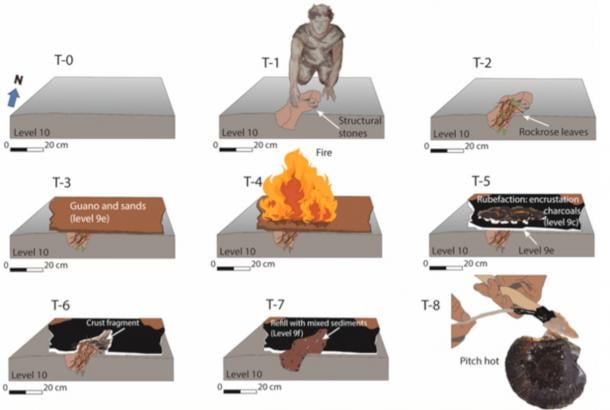🔴 Website 👉 https://u-s-news.com/
Telegram 👉 https://t.me/usnewscom_channel
A recent discovery in Gibraltar has unveiled one of the most advanced manufacturing sites of the ancient world: a Neanderthal tar distillation oven dating back 65,000 years. Hidden in Vanguard Cave, part of the UNESCO-listed Gorham’s Cave Complex, this find offers compelling evidence of the technological prowess of our ancient cousins.
Led by the University of Murcia, the research team uncovered a specialized hearth structure where Neanderthals processed tar from resin-rich plants like rockrose (Cistaceae), reports Phys.org. The tar, used as an adhesive to bind stone tools to wooden handles, represents a remarkable innovation that predates similar techniques by modern humans by over 100,000 years.
Evidence of Complex Fire Use
The study, published in Quaternary Science Reviews, analyzed a unique hearth pit structure at the cave site. It featured a central fire area flanked by two trenches and was covered with a seal made of guano and sand to create a low-oxygen environment essential for tar production. This deliberate construction suggests a high degree of planning and an understanding of fire manipulation.
Organic geochemical analysis detected compounds such as levoglucosan and retene, indicative of burning resinous plants, and lipid biomarkers from rockrose leaves. Charcoal from the site further supported controlled low-temperature combustion, essential for extracting tar without burning the plant material entirely.
Micromorphological analysis of the hearth revealed no evidence of heating above 500°C, consistent with low-oxygen, low-temperature conditions. Surrounding sediments lacked pollen, while the hearth contained abundant grains, suggesting that Neanderthals deliberately added specific plants to the fire.
The anthropogenic structure could have been made following these steps. (Ochando et al/Quaternary Science Reviews)
Experimental Archaeology Validates Ancient Methods
To verify their findings, the team recreated a similar fire structure using only tools and materials available to Neanderthals. By heating rockrose leaves in low-oxygen conditions, they successfully produced tar sufficient to haft stone spearheads. This experiment confirmed that the Vanguard Cave hearth design was purpose-built for tar distillation.
Redefining Neanderthal Capabilities
This discovery challenges outdated stereotypes of Neanderthals as primitive or less advanced than early Homo sapiens. Constructing a hearth designed for specialized tasks like tar production demonstrates cognitive complexity, problem-solving skills, and cultural sophistication.
In addition to their use of fire for warmth, cooking, and light, Neanderthals clearly understood its potential for technological applications. The ability to produce tar highlights their ingenuity and reinforces the growing recognition of Neanderthals as capable and adaptive.
Top image: The researchers built and tested a replica of the hearth, and after about four hours of work, they had enough resin to attach two stone points to spears. Source: Juan Ochando et al./ Quaternary Science Reviews
By Gary Manners

